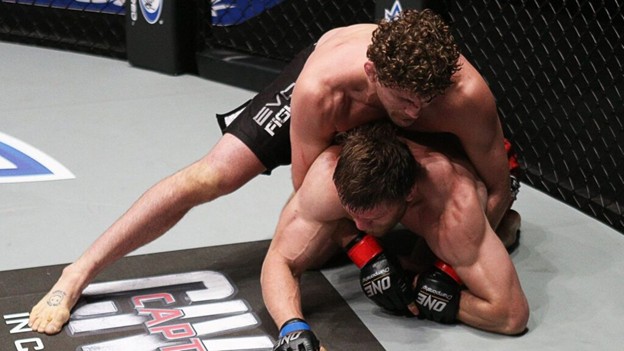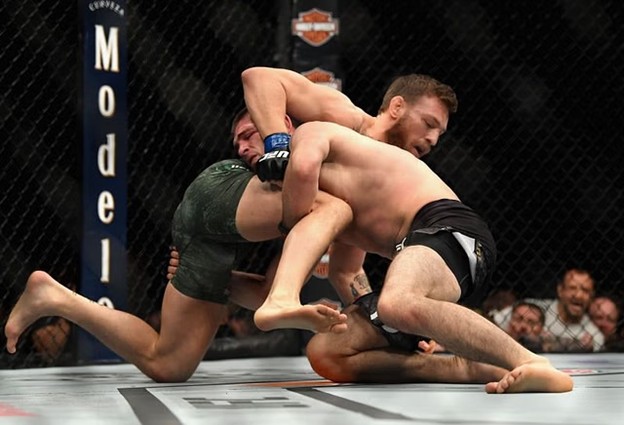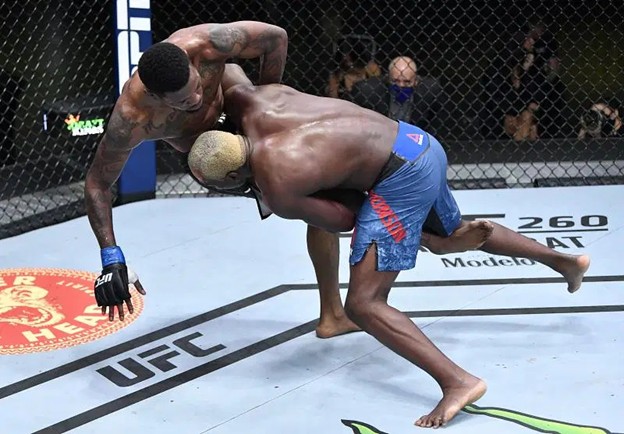
When you look at today’s UFC champions and top contenders, one thing stands out right away: most of them have a strong wrestling background. From Khabib Nurmagomedov’s suffocating grappling to Kamaru Usman’s relentless pressure, wrestling has become the gold standard for success inside the Octagon.
It wasn’t always this way. In the early days of MMA, you had specialists from every discipline—boxers, jiu-jitsu masters, kickboxers, and karate experts—all testing their styles against each other. Over time, however, wrestling proved to be the most adaptable and reliable foundation. The numbers back it up too. If you scan the history of UFC champions, an overwhelming percentage either wrestled at a high level or built their MMA game around wrestling principles.
So, why exactly are wrestlers dominating modern UFC? And what makes this skill set so hard to deal with? Let’s break it down.
The Wrestling Advantage in MMA
At its core, wrestling is about control. If you can take your opponent down and keep them there, you decide where the fight takes place. That ability alone gives wrestlers a huge edge over pure strikers or jiu-jitsu players.
Unlike striking arts, wrestling doesn’t rely on timing a perfect punch or kick. It’s about persistence, leverage, and relentless pressure. Even if you fail on your first takedown attempt, chain wrestling allows you to transition smoothly into another attack—whether it’s a single-leg, double-leg, or body lock.
Another key advantage is cage wrestling, something unique to MMA. Wrestlers use the fence like an extra weapon, pinning opponents against it, wearing them down, and setting up takedowns from close range. This style isn’t found in Olympic or collegiate wrestling, but it’s become one of the most important aspects of modern UFC combat.
In short, wrestling lets fighters dictate the pace, the location, and often the outcome of a fight. That’s why you’ll hear the old saying: “If two fighters are equal everywhere else, the better wrestler usually wins.”
Key Strategies Wrestlers Use to Dominate

So how exactly do wrestlers impose their will inside the cage? Let’s look at the main strategies that make them so effective:
1. Pressure Fighting
Wrestlers are masters at cutting off the cage. They keep their opponents moving backward, which is one of the worst positions in striking. When you’re backing up, your power drops, your options shrink, and the wrestler is closing the distance to set up a takedown.
2. The Takedown Threat
Even when a wrestler doesn’t shoot in, the constant threat changes the fight. Strikers can’t fully commit to kicks or combos because they’re worried about being taken down. This gives the wrestler’s own striking a boost—Kamaru Usman, for example, developed a dangerous jab that worked partly because opponents feared his wrestling.
3. Top Control and Ground-and-Pound
Judges reward dominance, and nothing screams control like pinning someone to the canvas. From top position, wrestlers land short but powerful strikes, rack up control time, and frustrate their opponents. It’s not flashy, but it wins rounds and often breaks opponents mentally.
4. Chain Wrestling
Unlike a single move in jiu-jitsu or a single strike in boxing, wrestling is about continuous pressure. If a double-leg fails, a wrestler transitions to a single-leg, then to a trip, then to a body lock. This relentless style forces opponents into constant defense until they eventually crack.
The Evolution of Wrestling in the UFC
Wrestling has always been part of the UFC, but the way it’s used has changed dramatically over the years.
In the late 1990s and early 2000s, fighters like Mark Coleman and Randy Couture relied heavily on wrestling with a ground-and-pound style. They would take their opponents down and hold them there, which earned wins but also criticism for being “boring.”
As MMA evolved, so did the wrestlers. The modern generation blends wrestling with striking and submissions, making their attacks much more dynamic. Instead of just pinning opponents, they use wrestling to create opportunities.
- Khabib Nurmagomedov wasn’t just holding people down—he was constantly advancing position, landing strikes, and hunting submissions.
- Kamaru Usman used wrestling to keep fights standing when he wanted, surprising many with his knockout power.
- Islam Makhachev takes wrestling even further, mixing in sambo-style trips and strong jiu-jitsu to dominate both on the feet and the ground.
The big difference today is that wrestling is no longer a one-dimensional base. It’s a launching pad for a complete MMA skill set.
Case Studies: Modern UFC Wrestlers
To see how powerful wrestling really is, let’s take a closer look at some fighters who’ve turned it into championship success:
Khabib Nurmagomedov
Undefeated at 29-0, Khabib built his legacy on Dagestani wrestling. His style wasn’t just about taking people down—it was about never giving them a second to breathe. He chained takedowns with mat returns, used the cage to trap opponents, and unleashed suffocating ground-and-pound. Fighters often admitted they felt helpless against his pressure.
Kamaru Usman
Nicknamed “The Nigerian Nightmare,” Usman’s Division II wrestling background became the foundation for one of the longest win streaks in UFC history. What made him special was how he combined wrestling pressure with sharp striking, particularly his jab and clinch work. Opponents couldn’t guess if he was about to wrestle or punch them in the face.
Islam Makhachev
As the heir to Khabib, Islam has taken the wrestling-based approach and added a strong submission game. His sambo background makes him a nightmare on the ground, but he’s also comfortable striking. His ability to mix levels and stay unpredictable makes him one of the toughest puzzles in the UFC today.
Bo Nickal
While still new to the UFC, Bo Nickal represents the next wave of NCAA wrestlers entering MMA. A three-time national champion, he’s already shown explosive takedowns and quick finishes. If he can round out his striking, he could be a dominant force in the middleweight division for years to come.
Why Other Martial Arts Struggle Against Wrestling

It’s not that striking or jiu-jitsu are weak arts—it’s just that wrestling neutralizes them better than anything else.
- Strikers have the hardest time. You can’t land your best punches and kicks if you’re constantly worried about a takedown. Many elite kickboxers step into MMA with strong striking records, only to get grounded by a wrestler who shuts down their offense.
- Jiu-jitsu fighters often rely on working from their guard. But in modern UFC, judges don’t value submission attempts from the bottom as much as top control. A wrestler can sit in guard, land short strikes, and rack up points while the jiu-jitsu specialist struggles to create space.
- Kickboxers and Muay Thai fighters are vulnerable too. Throwing a leg kick or knee exposes you to level changes. Unless you’ve got elite takedown defense, it’s a gamble every time you commit to a strike.
This doesn’t mean other styles can’t succeed, but it shows why wrestlers have the built-in advantage. They can force the fight into a realm where they’re strongest—and that’s a luxury not every discipline provides.
Counter-Strategies Against Wrestlers
Of course, not everyone is doomed against a high-level wrestler. Some fighters have figured out ways to turn the tide:
Takedown Defense (TDD)
Israel Adesanya is the perfect example. Despite being a kickboxer by trade, his takedown defense is sharp enough to keep most fights standing. By sprawling, circling off the cage, and anticipating level changes, he forces wrestlers to strike with him—where he has the clear edge.
Footwork and Space Creation
Fighters like Ciryl Gane use movement to avoid being trapped against the cage. If you don’t let the wrestler cut you off, it’s much harder for them to shoot in effectively.
Submissions from Scrambles
Charles Oliveira showed that even if you get taken down, you can turn scrambles into opportunities. By being dangerous off his back and attacking transitions, he keeps wrestlers hesitant to fully commit.
Cardio Battles
Some strikers have learned to make wrestlers pay by forcing high output. Wrestling is exhausting, and if a wrestler can’t secure control, they gas out quickly. Fighters like Max Holloway (though not a wrestler himself) have shown how relentless pace can wear down grappling-heavy opponents.
Still, these counters require elite skill, conditioning, and discipline. For the average fighter, facing a world-class wrestler is one of the toughest assignments in MMA.
The Future of Wrestling in the UFC
Looking ahead, it’s clear wrestling will remain the foundation of modern UFC success. But the style itself is still evolving.
- Dagestani Domination: Fighters from Dagestan and the broader Caucasus region are setting the standard. Their blend of sambo, wrestling, and ground control is shaping how future champions will train.
- NCAA to UFC Pipeline: More college wrestlers like Bo Nickal are making the jump to MMA earlier in their careers. With the athleticism and discipline built from years of wrestling, they’re adapting quickly.
- Complete MMA Wrestlers: The new breed isn’t just about takedowns—they’re striking, submitting, and mixing it all together. This adaptability will only widen the gap between elite wrestlers and one-dimensional fighters.
One question fans often ask: Will there ever be a time when wrestling isn’t dominant in the UFC? The short answer is unlikely. As long as fights can end up on the ground, the ability to control where the fight takes place will always be the ultimate advantage.
Conclusion
Wrestling has proven itself to be the most dominant base in MMA—not just in the early days, but even more so in the modern UFC. From legends like Randy Couture to undefeated greats like Khabib and rising stars like Bo Nickal, the story is the same: wrestling dictates the fight.
While strikers, kickboxers, and jiu-jitsu masters still shine, they all face the same challenge when matched with an elite wrestler—staying on their feet long enough to use their weapons. That’s why most current champions either come from a wrestling background or have developed strong takedown defense to survive.
As the sport continues to grow, we’ll see new techniques, hybrid styles, and evolving strategies. But one thing is certain: in modern UFC, if you don’t wrestle, you don’t reign.

Jake Simmons is a combat sports writer and UFC betting analyst. He breaks down fights with a sharp eye for strategy and provides insights on the business side of MMA.



Great write-up. My only complaints are the omission of Matt Hughes and GSP for their role in evolution of wrestling in MMA. But I guess you couldn’t get everyone, I’m sure I am missing some yet…
Thanks so much for reading and taking the time to comment! 🙏 You’re absolutely right—Matt Hughes and GSP were monumental in shaping wrestling’s role in MMA. I tried to highlight some key examples, but there’s definitely room for a more comprehensive look. I appreciate the feedback and might consider a follow-up piece to cover more legends like them.